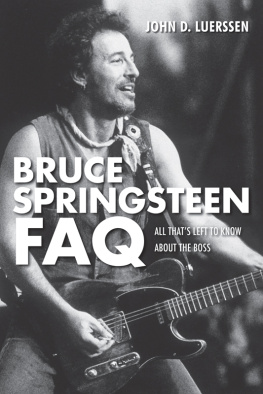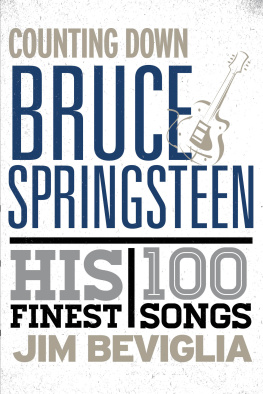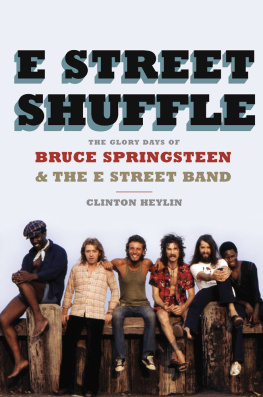CONTENTS
Guide
BOSS
BRUCE SPRINGSTEEN AND THE E STREET BANDTHE ILLUSTRATED HISTORY
GILLIAN G. GAAR


2016 Quarto Publishing Group USA Inc.
Text 2016 Gillian G. Gaar
First published in 2016 by Voyageur Press, an imprint of Quarto Publishing Group USA Inc., 400 First Avenue North, Suite 400, Minneapolis, MN 55401 USA. Telephone: (612) 344-8100 Fax: (612) 344-8692
quartoknows.com
Visit our blogs at quartoknows.com
All rights reserved. No part of this book may be reproduced in any form without written permission of the copyright owners. All images in this book have been reproduced with the knowledge and prior consent of the artists concerned, and no responsibility is accepted by producer, publisher, or printer for any infringement of copyright or otherwise, arising from the contents of this publication. Every effort has been made to ensure that credits accurately comply with information supplied. We apologize for any inaccuracies that may have occurred and will resolve inaccurate or missing information in a subsequent reprinting of the book.
Voyageur Press titles are also available at discounts in bulk quantity for industrial or sales-promotional use. For details contact the Special Sales Manager at Quarto Publishing Group USA Inc., 400 First Avenue North, Suite 400, Minneapolis, MN 55401 USA.
Digital edition: 978-0-76035-127-7
Hardcover edition: 978-0-76034-972-4
Library of Congress Cataloging-in-Publication Data
Names: Gaar, Gillian G., 1959
Title: Boss : Bruce Springsteen and the E Street Band : the illustrated history / by Gillian G. Gaar.
Description: Minneapolis, MN : Voyageur Press, 2016. | Includes index.
Identifiers: LCCN 2016002289 | ISBN 9780760349724 (plc)
Subjects: LCSH: Springsteen, Bruce. | E Street Band. | Rock musiciansUnited States. | Springsteen, BrucePortraits. | E Street BandPortraits. | Rock musiciansUnited StatesPortraits.
Classification: LCC ML420.S77 G25 2016 | DDC 782.42166092dc23
LC record available at http://lccn.loc.gov/2016002289
Acquiring Editor: Todd R. Berger
Project Manager: Caitlin Fultz
Art Director: Cindy Samargia Laun
Book Design and Layout: Brad Norr Design
On the front cover: Richard E. Aaron/Redferns
On the Claudia Candido / Alamy Stock Photo
On the epa european pressphoto agency b.v. / Alamy Stock Photo
INTRODUCTION
ELVIS, BRUCE, AND ROCK N ROLL DREAMS
T hey were the television shows that transfixed the nation.
Elvis Presley, after making his national TV debut on Stage Show, then outraging the country with his swiveling hips on The Milton Berle Show, then being stuffed into a tux in a vain attempt to neuter him on The Steve Allen Show, was finally going to appear on the most popular variety program in the United States. The King of Rock n Roll made three landmark appearances on The Ed Sullivan Show: September 9, 1956; October 28, 1956; and January 6, 1957. He would not be seen on television again for another three years.
Bruce Springsteen, who was just about to turn seven when that first appearance aired, was watching. Elvis sounded different, looked different, and moved differently from every other male singer he had ever seen. Certainly there would be other musical influences in Bruces life. But the original inspiration to make musicand, more specifically, to make rock n roll musicgoes back to Elvis.
The kid who watched Elvis bop his way through Dont Be Cruel and Hound Dog would have been flabbergasted to hear that one day hed be a rock star toocalled the future of rock n roll, no lessthe inheritor of Elviss crown. Young Bruce grew up believing in the redemptive power of rock n roll. But by the time he ascended to star status, he could also see his childhood heros story as a cautionary tale.
Springsteen at the Oakland-Alameda County Coliseum in October 1980, during The River tour; the record was his first double album. Ed Perlstein/Redferns
Both men grew up in families of little means (though at least Springsteen always had electricity and running water at home). Both loved music of every genre, absorbing it wherever it could be found. And in the early years of their careers, they evinced a similar determination. Prior to recording for Sun Records, Elvis dropped by the studio on several occasions, making demos, asking if studio owner Sam Phillips might be looking for a singer, ingratiating himself with the office manager, Marion Keisker, who finally persuaded her boss to give the kid a break. Springsteen was so keen on making music his career that he never even sought a day job: he allowed nothing to distract him from his goal. He turned down a contract with music impresario Bill Graham because he didnt think his band was ready, and he kept forming groups and breaking them up, tinkering with the lineup until he was truly satisfied with his players.
Elvis Presley rehearsing for his Ed Sullivan Show appearance in January 1957. Springsteen adored the King of Rock n Roll and frequently performed Presleys songs in concert. Michael Ochs Archives/Getty Images
When Springsteen speaks of Elvis in concert it is always with reverence: It was like he came along and whispered some dream in everybodys ear and somehow we all dreamed it, he said, introducing Elviss Follow That Dream during a concert. In April 1976, he famously jumped over the gates of Graceland, in an attempt to meet the King (who wasnt home).
In May 1977, he saw Elvis in concert but was dismayed to see his heros obvious deterioration. Just three months later, Elvis was dead. I remember I was sitting at home when a friend of mine called and told me that hed died, Springsteen said during a 1981 concert, and it wasnt that big a surprise at the time, cause Id seen him a few months earlier in Philadelphia. I thought a lot about it, how somebody whod had so much could in the end lose so bad, and how dreams dont mean nothing unless youre strong enough to fight for em and make em come true.
The high price of fame weighed heavily on Springsteen. His first big influx of attention, in the 1970s, left him feeling uneasy. I used to feel I always was in control, he told the New Musical Express in 1975. But now Im not so sure. Asked about his own image at a press conference in 1972, Elvis had answered, Well, the image is one thing, and a human being is another. Its very hard to live up to an image. Springsteen would certainly have agreed.















